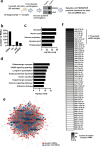The Coding and Small Non-coding Hippocampal Synaptic RNAome
- PMID: 33569760
- PMCID: PMC8128755
- DOI: 10.1007/s12035-021-02296-y
The Coding and Small Non-coding Hippocampal Synaptic RNAome
Erratum in
-
Correction to: The Coding and Small Non-coding Hippocampal Synaptic RNAome.Mol Neurobiol. 2021 Jun;58(6):2954. doi: 10.1007/s12035-021-02349-2. Mol Neurobiol. 2021. PMID: 33710584 Free PMC article. No abstract available.
Abstract
Neurons are highly compartmentalized cells that depend on local protein synthesis. Messenger RNAs (mRNAs) have thus been detected in neuronal dendrites, and more recently in the pre- and postsynaptic compartments as well. Other RNA species such as microRNAs have also been described at synapses where they are believed to control mRNA availability for local translation. A combined dataset analyzing the synaptic coding and non-coding RNAome via next-generation sequencing approaches is, however, still lacking. Here, we isolate synaptosomes from the hippocampus of young wild-type mice and provide the coding and non-coding synaptic RNAome. These data are complemented by a novel approach for analyzing the synaptic RNAome from primary hippocampal neurons grown in microfluidic chambers. Our data show that synaptic microRNAs control almost the entire synaptic mRNAome, and we identified several hub microRNAs. By combining the in vivo synaptosomal data with our novel microfluidic chamber system, our findings also support the hypothesis that part of the synaptic microRNAome may be supplied to neurons via astrocytes. Moreover, the microfluidic system is suitable for studying the dynamics of the synaptic RNAome in response to stimulation. In conclusion, our data provide a valuable resource and point to several important targets for further research.
Keywords: Gene expression; RNA sequencing; Synapse; Synaptosomes; lncRNA; mRNA; microRNA; snoRNA.
Conflict of interest statement
The authors declare no conflict of interest.
Figures





Similar articles
-
The RNA-Binding Protein hnRNP K Mediates the Effect of BDNF on Dendritic mRNA Metabolism and Regulates Synaptic NMDA Receptors in Hippocampal Neurons.eNeuro. 2017 Dec 12;4(6):ENEURO.0268-17.2017. doi: 10.1523/ENEURO.0268-17.2017. eCollection 2017 Nov-Dec. eNeuro. 2017. PMID: 29255796 Free PMC article.
-
GluA2 mRNA distribution and regulation by miR-124 in hippocampal neurons.Mol Cell Neurosci. 2014 Jul;61:1-12. doi: 10.1016/j.mcn.2014.04.006. Epub 2014 Apr 28. Mol Cell Neurosci. 2014. PMID: 24784359 Free PMC article.
-
Expression of microRNAs and their precursors in synaptic fractions of adult mouse forebrain.J Neurochem. 2008 Jul;106(2):650-61. doi: 10.1111/j.1471-4159.2008.05413.x. Epub 2008 Apr 12. J Neurochem. 2008. PMID: 18410515 Free PMC article.
-
Analysis of mRNA translation in cultured hippocampal neurons.Methods Enzymol. 2007;431:143-62. doi: 10.1016/S0076-6879(07)31008-2. Methods Enzymol. 2007. PMID: 17923234 Review.
-
The RNA-centred view of the synapse: non-coding RNAs and synaptic plasticity.Philos Trans R Soc Lond B Biol Sci. 2014 Sep 26;369(1652):20130504. doi: 10.1098/rstb.2013.0504. Philos Trans R Soc Lond B Biol Sci. 2014. PMID: 25135965 Free PMC article. Review.
Cited by
-
Clinical Insights into MicroRNAs in Depression: Bridging Molecular Discoveries and Therapeutic Potential.Int J Mol Sci. 2024 Mar 1;25(5):2866. doi: 10.3390/ijms25052866. Int J Mol Sci. 2024. PMID: 38474112 Free PMC article. Review.
-
A Proposed Role for Interactions between Argonautes, miRISC, and RNA Binding Proteins in the Regulation of Local Translation in Neurons and Glia.J Neurosci. 2022 Apr 20;42(16):3291-3301. doi: 10.1523/JNEUROSCI.2391-21.2022. J Neurosci. 2022. PMID: 35444007 Free PMC article. Review.
-
Distinct small non-coding RNA landscape in the axons and released extracellular vesicles of developing primary cortical neurons and the axoplasm of adult nerves.RNA Biol. 2021 Nov 12;18(sup2):832-855. doi: 10.1080/15476286.2021.2000792. Epub 2021 Dec 9. RNA Biol. 2021. PMID: 34882524 Free PMC article.
-
Spatiotemporal Regulation of Transcript Isoform Expression in the Hippocampus.Front Mol Neurosci. 2021 Jul 8;14:694234. doi: 10.3389/fnmol.2021.694234. eCollection 2021. Front Mol Neurosci. 2021. PMID: 34305526 Free PMC article.
-
Conserved reduction of m6A RNA modifications during aging and neurodegeneration is linked to changes in synaptic transcripts.Proc Natl Acad Sci U S A. 2023 Feb 28;120(9):e2204933120. doi: 10.1073/pnas.2204933120. Epub 2023 Feb 22. Proc Natl Acad Sci U S A. 2023. PMID: 36812208 Free PMC article.
References
-
- Biever A, Glock C, Tushev G, Ciirdaeva E, Dalmay T, Langer JD, Schuman EM. Monosomes actively translate synaptic mRNAs in neuronal processes. Science (New York, NY) 2020;367(6477):eaay4991. - PubMed
-
- Fonkeu Y, Kraynyukova N, Hafner AS, Kochen L, Sartori F, Schuman EM, Tchumatchenko T. How mRNA localization and protein synthesis sites influence dendritic protein distribution and dynamics. Neuron. 2019;103:1109–1122. - PubMed
-
- Holt CE, Martin KC, Schuman EM. Local translation in neurons: visualization and function. Nat Struct Mol Biol. 2019;26(7):557–566. - PubMed
-
- Kosik KS. Low Copy Number: How Dendrites Manage with So Few mRNAs. Neuron. 2016;92:1168–1180. - PubMed
MeSH terms
Substances
LinkOut - more resources
Full Text Sources
Other Literature Sources
Molecular Biology Databases

